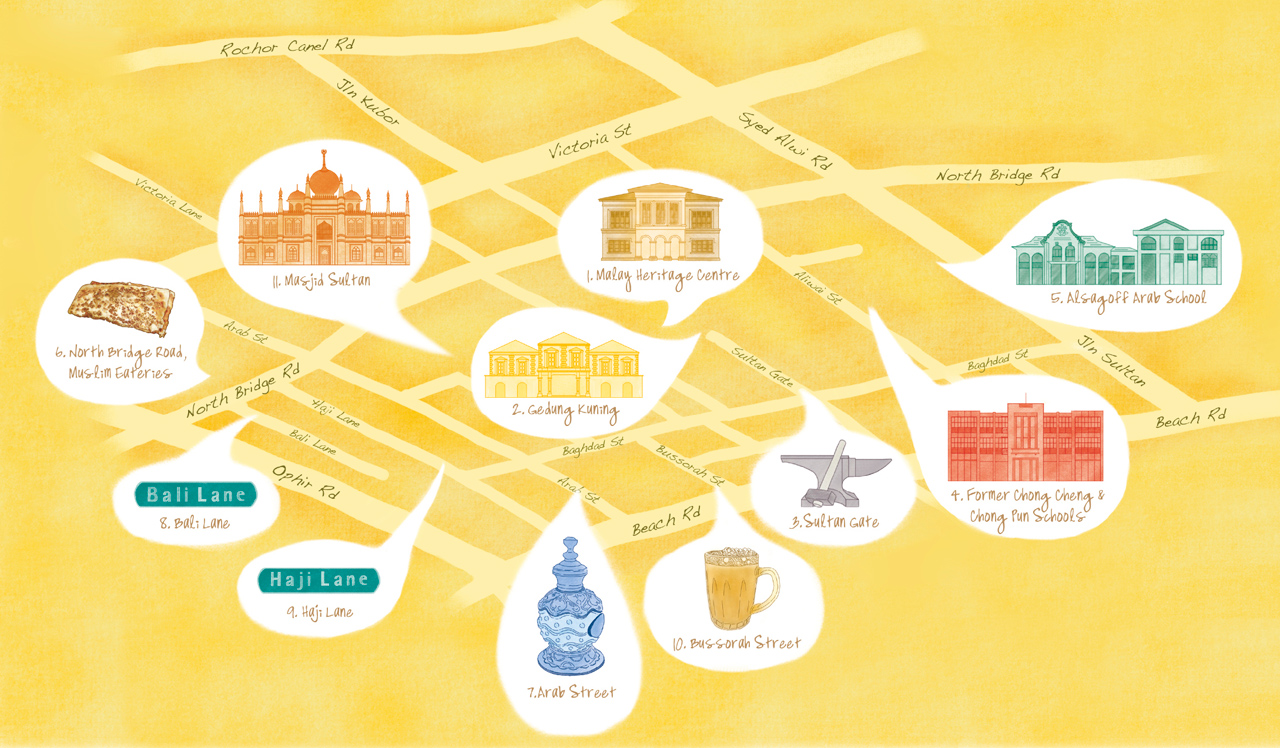2 Walking Trails for a Weekend in History
Walking doesn’t have to be boring, especially when you are traipsing through history and heritage. Challenge offers up two self-guided trails that will get your hearts a-pumping and your imagination racing.
This trail was extracted from Kampong Glam: A Heritage Trail by NHB, 2012.
A Royal Tour

Estimated walking time: 2 hours
Download the comprehensive Kampong Glam trail booklet at bit.ly/KampongGlam_NHB
Kampong Glam’s eclectic mix of cultures, traditions and food is well known. But did you know that Malay royalty once resided here? You can now get acquainted with the area’s royal heritage with the National Heritage Board (NHB)’s newest trail.
The first stop is of course the Malay Heritage Centre, a museum which was once the Istana (palace) of the then Malay rulers. When Sir Stamford Raffles signed a treaty in 1819 to set up a trading post in Singapore, the Sultan of Johor and Singapore brought his family to settle down in Kampong Glam. He built a walled compound that included the Istana.
Next to the museum is a distinctive, bright yellow bungalow, known as Gedung Kuning (Yellow Mansion) for its hue. The traditional Malay house, believed to have been built about the same time as the former Istana, is now a restaurant.
For those who prefer a more laissez-faire approach, there’s no need to follow the rest of the trail stops in sequence from here on. Read the rich descriptions of Kampong Glam’s landmarks as you wander through its labyrinthine streets for a full-on assault of the senses. Have fun spotting the myriad architectural into flavourful nasi padang at the eateries along North Bridge Road – one of the earliest roads built in Singapore; sniff out the age-old trade of crafting attar (non-alcohol perfumes) at some of the oldest attar shops in Singapore.
Depending on the time of the day, you might even hear the muezzin call to the faithful to prayer at the nearby Sultan Mosque. The majestic national monument was constructed in 1924 to replace the original mosque that was built by the Sultan in 1824.
Want a perfect ending to the royal tour? Have a teh tarik at any of the cafes lining Bussorah Street, which once upon a time was “Sultan Road”.

1. Malay Heritage Centre The centre was the residence of Malay royalty and known as ‘Istana Kampong Gelam’.
2. Gedung Kuning The “Yellow Mansion” is thought to have been built about the same time as Istana Kampong Gelam.
3. Sultan Gate Reputed for its blacksmiths, the road was commonly known as pakti koi (blacksmith street) in Hokkien.
4. Former Chong Cheng & Chong Pun Schools Started by the Hokkien community, these schools gave much-needed education when Singapore’s educational infrastructure was lacking.
5. Alsagoff Arab School Established in 1912, it is the oldest surviving madrasah in Singapore.
6. Muslim eateries along North Bridge Road One of the earliest roads built in Singapore, this road is so called because it runs north of Elgin Bridge.
7. Bazaar-style shopping along Arab Street The area was designated for the Arab community in the 1822 town plan of Singapore.
8. Bali Lane The population that lived here in the 1850s were mostly Javanese from Bali, Lombok and Sumbawa.
9. Haji Lane It is the narrowest street in Singapore.
10. Bussorah Street Famed for its food, culture and several distinctive kampongs, the street and its vicinity are regarded as the heart of Kampong Glam.
11. Masjid Sultan An important focal point for Muslims in Singapore and the most prominent landmark in Kampong Glam.
The Occupation Years
This trail was extracted from Singapore in World War II: A Heritage Trail by NHB, 2012.

Estimated walking time: 3 hours
Download the entire World War II trail booklet at bit.ly/worldwarII_trail
Have you sometimes heard whispered tales of war sites in Singapore, but can’t quite put your finger on where they used to be? A World War II trail booklet produced by NHB may be just what you need.
Launched in February 2012 to mark the 70th anniversary of the fall of Singapore, the booklet retraces the historic event with 50 war sites across the island described in brief. It’s unlikely anyone would attempt the entire self-guided trail in a day so the booklet breaks it down into six shorter trails.
Among them is “City: Remembering the Occupation Years”, which covers 15 war sites in the central district. This trail brings you back to the significant events that took place in the heart of Singapore between 1942 and 1945.
Some places of interests include Hong Lim Complex, which was the Sook Ching Screening Centre where the Kempeitai (Japanese military police) carried out mass screening of the Chinese male population to identify anti-Japanese elements. Those who survived the inspection walked out with “Examined” stamped on their faces. The rest were killed.
Over on Orchard Road is The Cathay, which was where the Japanese Military Propaganda Department operated to spread the Japanese language and culture. People could only listen to Radio Syonan and those found with broken radio seals were punishable by death.
The City trail takes you to some familiar landmarks like the Lim Bo Seng Memorial but there are also lesser known sites such as the Indian National Army Monument dedicated to the “unknown warrior” killed in the war.
Covering the 15 sites on foot can take up to three hours. But you can take plenty of breaks in between, or pick and choose certain sites to visit. If you time it well, you could top off your exhausting walk with a sunset finish at the old Kallang Airport, which was the last holdout for the Allied air force.

1. Sook Ching Screening Centre (Hong Lim Complex) The centre where Chinese males were screened to identify anti-Japanese elements.
2. Fort Canning Command Centre This became the headquarters for Major-General Kawamura Saburo after the British surrendered.
3. The Cathay The cinema was used as a centre to broadcast propaganda messages for the Japanese.
4. Kempeitai Headquarters (YMCA) This was the site of the original YMCA building which was used by the Japanese for interrogation and torture. The original building was demolished in 1981.
5. Raffles Library & Museum (National Museum of Singapore)During the war, the library’s and museum’s invaluable collections were preserved through a unique Japanese and British collaboration.
6. Former St Joseph’s Institution (Singapore Art Museum) This was the temporary barracks for the Japanese soldiers during the occupation.
7. Padang Thousands of surrendered British military personnel and European civilians gathered on the field in 1942 before marching to their prison camps in Changi.
8. Municipal Building (City Hall) The Japanese’s last major surrender ceremony of the Second World War took place on September 12,1945.
9. St Andrew’s Cathedral When the Japanese attacked in February 1942, this church became an emergency hospital and a casualty clearing station for a week.
10. Esplanade Park
Lim Bo Seng Memorial Built in 1954 in memory of Major-General Lim Bo Seng who led Force 136, an anti-Japanese resistance movement.
Cenotaph Built in memory of those who gave their lives in World War One (1912-1918) with a second dedication added in remembrance of those who died in World War Two (1941-1945).
Indian National Army Monument Dedicated to the ‘unknown warrior’ of the Indian National Army, and also to soldiers killed while fighting in Burma.
11. Civilian War Memorial Commemorates the civilians who died during the Japanese invasion and occupation of Singapore.
12. Singapore Volunteer Corps Headquarters (Beach Road Camp)The headquarters for the Singapore Volunteer Corps that contributed to the war against the Japanese. Many were executed or made prisoners as a result.
13. Old Kallang Airfield The last operational airfield of the Allied air force was taken over by the Japanese in February 1942.
- POSTED ON
Jan 16, 2013
-
Out of Office
How To Rekindle Your Love for Your Job
-
Out of Office
Budget Lunches Below $10 For The Budget Season









